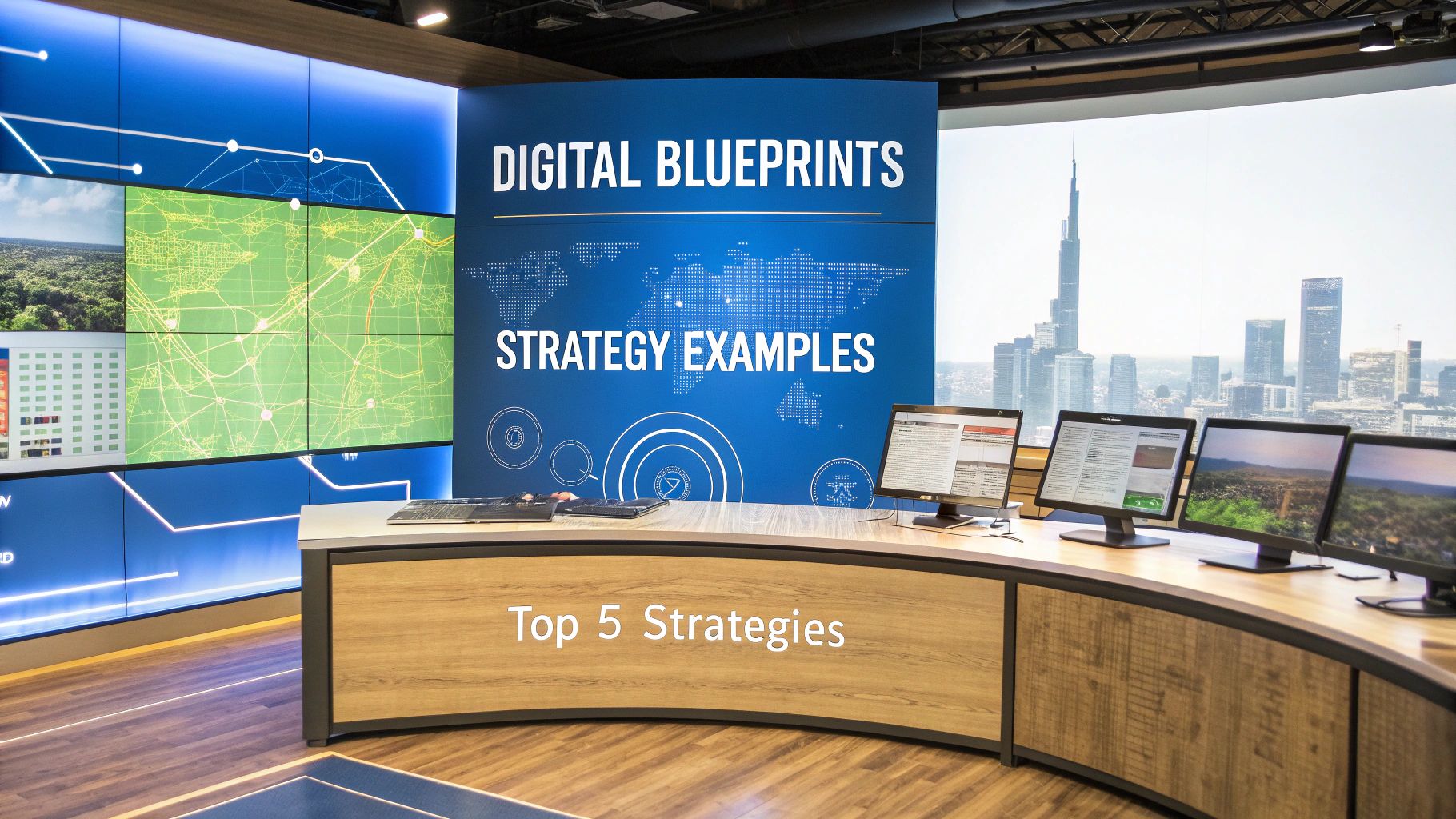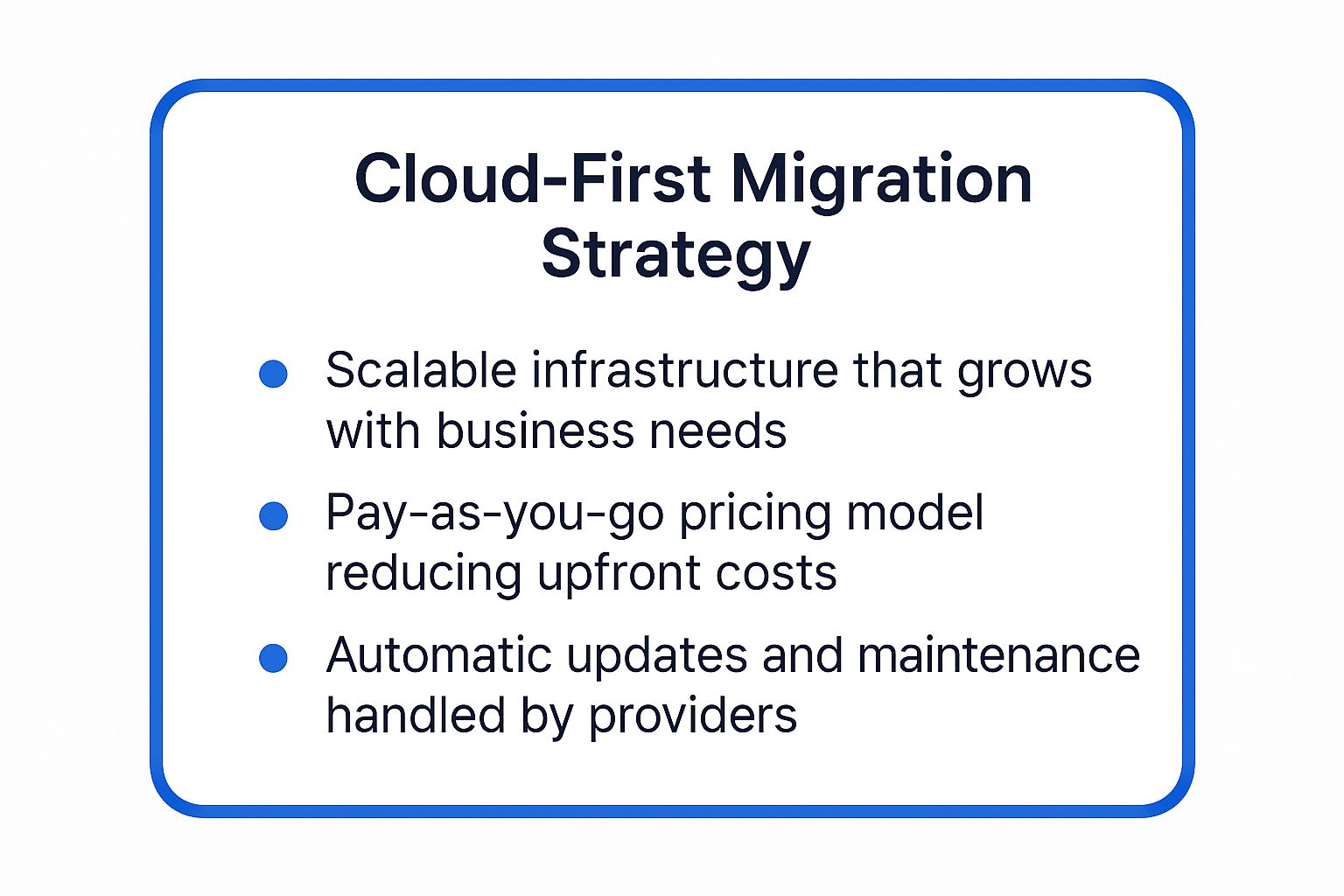Top 5 Digital Transformation Strategy Examples for 2025

Digital transformation is no longer a buzzword; it's the core engine of modern business success. But what does a winning strategy actually look like in practice? Moving beyond theory is crucial for any leader aiming to stay competitive, yet many organizations struggle to translate abstract concepts into concrete actions. This guide dives deep into tangible, real-world digital transformation strategy examples that have reshaped entire industries.
We will break down the specific tactics, strategic insights, and replicable methods behind the success of global leaders. For organizations looking to bring this level of expertise directly to their teams, thought leaders from platforms like Speak About AI can provide invaluable, firsthand insights on implementing these complex strategies. Often, the journey begins by addressing foundational technologies. To effectively navigate this initial phase, exploring actionable legacy system modernization strategies is a critical first step toward unlocking agility and efficiency.
This article moves past generic success stories to provide a clear, actionable blueprint for innovation. We will explore eight powerful models for building a future-proof organization, covering everything from cloud-first migrations and AI integration to customer experience overhauls and workforce enablement. Let's examine the detailed strategies you can adapt and apply today.
1. Cloud-First Migration Strategy
A cloud-first migration is a foundational digital transformation strategy where an organization prioritizes moving its IT infrastructure, applications, and data to cloud-based platforms over maintaining traditional on-premises systems. This approach shifts capital expenditures on physical servers to operational expenses on services from providers like AWS, Azure, or Google Cloud. The core goal is to gain scalability, operational agility, and cost-efficiency by leveraging the cloud for computing, storage, and networking.
This strategy is particularly effective for businesses aiming for rapid growth or global scale. Companies like Netflix and Spotify are prime examples of this strategy in action. Netflix migrated its entire infrastructure to AWS, a move that enabled it to scale its streaming service globally and handle massive, fluctuating user demand without the burden of managing physical data centers. Similarly, Spotify leverages Google Cloud Platform to process billions of daily song requests and deliver a seamless user experience worldwide.
Strategic Breakdown
Implementing a cloud-first strategy involves more than just a technical shift; it's a fundamental change in business operations. The strategy unlocks significant competitive advantages by enabling faster innovation cycles and resource optimization. For instance, Capital One completed its full migration to AWS in 2021, closing all its physical data centers. This allowed the financial services giant to innovate faster, build more resilient applications, and leverage cloud-native machine learning and data analytics to enhance customer experiences and security.
Strategic Insight: A successful cloud migration isn't just about "lifting and shifting" applications. It's about re-architecting for the cloud (refactoring) to fully exploit capabilities like auto-scaling, serverless computing, and managed services. This maximizes ROI and builds a truly agile foundation.
This approach is one of the most powerful digital transformation strategy examples because it directly addresses core business needs for flexibility and speed.
The infographic below summarizes the core benefits that make a cloud-first strategy so compelling.

These three pillars highlight how the cloud transforms IT from a cost center into a strategic enabler of business growth and innovation.
Actionable Takeaways
To replicate this success, organizations should adopt a phased and strategic approach.
- Assess and Prioritize: Begin with a comprehensive audit of all applications to determine their cloud readiness. Start by migrating non-critical workloads to build institutional knowledge and minimize initial risk.
- Invest in Skills: Your team is your most critical asset. Invest in cloud training and certifications to ensure your IT staff can effectively manage and optimize the new cloud environment.
- Establish Governance: Implement robust cloud governance policies from day one. Use cloud cost management tools to monitor spending, enforce security protocols, and ensure compliance, preventing budget overruns and security gaps.
2. Customer Experience (CX) Digital Transformation
A Customer Experience (CX) digital transformation is a strategy focused on reimagining every touchpoint in the customer journey using digital technologies. This approach integrates data analytics, AI, omnichannel platforms, and personalization engines to create seamless and highly personalized experiences across all interactions. The core goal is to boost customer satisfaction, loyalty, and lifetime value by leveraging digital tools to understand and anticipate customer needs.
This strategy is a game-changer for businesses in competitive markets where experience is the key differentiator. Companies like Starbucks and Disney are iconic examples of this strategy in practice. The Starbucks mobile app, which integrates loyalty rewards, mobile ordering, and personalized recommendations, now drives a significant portion of its sales. Similarly, Disney's MagicBand system provides a frictionless park experience, handling everything from entry and payments to FastPass reservations, all with a simple tap.

Strategic Breakdown
Implementing a CX transformation is not just about launching an app; it's about embedding a customer-first mindset into the organization's digital DNA. This strategy creates a powerful competitive moat by building deep emotional connections with customers. For instance, Domino's shifted from a pizza company to a tech-first e-commerce powerhouse by obsessing over the customer journey. Its Pizza Tracker and multiple ordering channels (voice, SMS, app) made ordering effortless and transparent, driving its digital sales to over 75% of total revenue.
Strategic Insight: True CX transformation is powered by unified data. Creating a single view of the customer by integrating data from all touchpoints is non-negotiable. This enables genuine personalization at scale, turning transactional interactions into meaningful relationships.
This approach is one of the most critical digital transformation strategy examples because it directly impacts the top line by turning satisfied customers into brand advocates.
Actionable Takeaways
To replicate this success, organizations must adopt a data-driven and customer-centric methodology.
- Map the Journey: Begin by mapping the complete customer journey to identify pain points and digital enhancement opportunities. Use this map as your strategic blueprint for prioritizing initiatives.
- Unify Customer Data: Implement a Customer Data Platform (CDP) to consolidate data from all sources-sales, marketing, service, and social media. A unified profile is the foundation for effective personalization.
- Balance Tech and Touch: While automation and AI can streamline interactions, ensure there is a clear path for customers to connect with a human for complex or sensitive issues. The goal is to enhance, not eliminate, the human element.
3. Data-Driven Decision Making and Analytics Strategy
A data-driven analytics strategy is a digital transformation that shifts an organization's core decision-making process from intuition to one based on evidence and insights derived from data. This approach involves building a robust data infrastructure to collect, process, and analyze vast information pools. The goal is to embed business intelligence, advanced analytics, and AI/ML capabilities into daily operations, empowering teams at all levels to make smarter, faster decisions.
This strategy is a cornerstone for companies seeking to gain a competitive edge through operational efficiency and deep customer understanding. Walmart, for instance, uses predictive analytics to manage inventory across its thousands of stores, significantly reducing waste while ensuring product availability. Similarly, Netflix's powerful recommendation engine, which drives over 80% of content viewed on the platform, is a direct result of analyzing viewing data from its massive subscriber base.
Strategic Breakdown
Implementing a data-driven strategy is about more than just deploying technology; it's about fostering a culture that values data as a strategic asset. The strategy unlocks new revenue streams, enhances customer experiences, and optimizes complex processes. For example, UPS implemented its On-Road Integrated Optimization and Navigation (ORION) system, which uses advanced algorithms and data analytics to optimize delivery routes. This initiative saves the company an estimated 10 million gallons of fuel and reduces emissions by 100,000 metric tons annually.
Strategic Insight: The most impactful data strategies begin with specific business problems, not with a desire to collect all available data. Starting with a clear question ensures that analytics efforts are focused, relevant, and deliver measurable business value from the outset.
This approach is one of the most critical digital transformation strategy examples because it turns information into a direct driver of business performance and innovation. To enhance your organization's capacity for informed decisions, delve into the strategies for modern data analytics leveraging AI for insights.
Actionable Takeaways
To build a successful data-driven culture, organizations must be deliberate and methodical.
- Establish Data Governance: Before scaling any analytics initiative, create a clear governance framework. This ensures data quality, security, and compliance, which are essential for building trust in the insights generated.
- Invest in Data Literacy: Democratize data skills by providing training for all employees, not just dedicated analytics teams. When everyone can speak the language of data, insights are adopted more quickly and effectively.
- Start with Business Questions: Avoid the "collect everything" approach. Instead, identify high-impact business questions and work backward to determine what data and analytics are needed to answer them. This ensures immediate and tangible ROI.
4. Agile and DevOps Transformation
An Agile and DevOps transformation is a profound cultural and operational shift that moves an organization from traditional, sequential development (waterfall) to a model of continuous, iterative, and collaborative delivery. This strategy dismantles the silos between development (Dev), operations (Ops), and business teams, fostering a unified culture focused on rapid, high-quality output. It leverages automation, continuous integration/continuous deployment (CI/CD) pipelines, and short feedback loops to deliver value to customers faster and more reliably.
This strategy is essential for companies in competitive markets where speed and responsiveness are critical. For instance, Amazon famously deploys new code every 11.7 seconds on average, enabling constant innovation and A/B testing at a massive scale. Similarly, Etsy transitioned from cumbersome biannual releases to over 50 deployments per day by embracing DevOps, allowing them to quickly adapt to market trends. This is a powerful digital transformation strategy example that directly enhances an organization's ability to innovate.

Strategic Breakdown
Implementing Agile and DevOps is more than adopting new tools; it's about rewiring the organizational culture for speed and collaboration. The strategy gives companies a powerful engine for experimentation and learning. For example, ING Bank restructured its IT department by organizing 3,500 employees into 350 autonomous "squads," mirroring the Spotify model. This radical change reduced their time-to-market for new products by over 30% and significantly increased employee engagement.
Strategic Insight: True DevOps transformation is culture-led, not tool-led. Success hinges on creating psychological safety where teams can experiment, fail, and learn without blame. The focus must be on shared ownership of the entire product lifecycle, from initial idea to production support.
This approach transforms technology delivery from a slow, risky process into a predictable, low-risk, and continuous flow of value. Adopting these principles often requires guidance from seasoned experts, and you can learn more from top technology keynote speakers who have led these changes at major companies.
Actionable Takeaways
To successfully implement this transformation, organizations must focus on both cultural and technical foundations.
- Start Small and Scale: Launch a pilot project with a cross-functional team to demonstrate value and work out kinks. Use the success of this pilot as a blueprint to scale Agile and DevOps practices across the wider organization.
- Automate Everything: Invest heavily in automation tools for the entire CI/CD pipeline, including code integration, testing, security scans, and infrastructure provisioning. This reduces manual errors and frees up engineers to focus on innovation.
- Measure What Matters: Establish clear, outcome-focused metrics to track progress. Focus on indicators like deployment frequency, lead time for changes, mean time to recovery (MTTR), and change failure rate to guide continuous improvement.
5. Digital Product and Business Model Innovation
Digital product and business model innovation is a transformative strategy where companies leverage technology to fundamentally reinvent their core offerings and revenue streams. Instead of just digitizing existing processes, this approach involves creating entirely new value propositions, shifting from one-time product sales to recurring revenue models like subscriptions, or building platform-based ecosystems. The goal is to meet evolving customer expectations and unlock new, sustainable growth channels.
This strategy is a hallmark of modern market leaders. Adobe famously executed this by shifting from selling perpetual software licenses to its subscription-based Creative Cloud. This move provided customers with constant updates and access to a suite of tools, while giving Adobe a predictable, recurring revenue stream that dramatically increased its market valuation. Similarly, Microsoft pivoted to a cloud-first model with Office 365 and Azure, transforming its business and capturing a massive share of the enterprise cloud market.
Strategic Breakdown
Implementing this strategy requires a deep understanding of customer needs and a willingness to cannibalize existing revenue streams for long-term gain. It’s about creating new markets, not just competing in old ones. For example, John Deere evolved from a traditional equipment manufacturer into a tech company by embedding IoT sensors and AI into its tractors. This created a new business model around precision agriculture, selling data-driven insights and services that help farmers increase yield and efficiency.
Strategic Insight: True business model innovation focuses on solving customer problems in entirely new ways. It’s not about adding a digital feature to an old product; it’s about rethinking how value is created and delivered, often by bundling hardware, software, and services into an inseparable experience.
This is one of the most powerful digital transformation strategy examples because it directly redefines a company's position in the market and creates durable competitive advantages.
Actionable Takeaways
To successfully innovate your products and business model, focus on a customer-centric and iterative approach.
- Validate Before Scaling: Test new business models with small-scale pilots or minimum viable products (MVPs) to gather real-world customer feedback and validate assumptions before committing significant resources.
- Embrace a Dual-Track Strategy: Maintain and optimize your existing revenue-generating products while simultaneously investing in a dedicated team to build and scale the new digital models. This de-risks the transition.
- Build a Platform Ecosystem: Design your digital offerings as platforms that can be extended by partners or third-party developers. This creates a network effect, adding value beyond what your company can build alone.
6. Automation and AI Integration Strategy
An Automation and AI Integration strategy focuses on deploying artificial intelligence (AI), machine learning (ML), and robotic process automation (RPA) to streamline operations, enhance decision-making, and create intelligent systems. Organizations use this approach to automate repetitive tasks, from customer service chatbots to predictive maintenance and financial processing. The core objective is to boost efficiency, reduce errors, and empower human employees to focus on higher-value, strategic activities.
This strategy is transformative for companies looking to optimize processes and unlock new data-driven capabilities. For instance, JP Morgan developed its COiN platform, which uses machine learning to analyze 12,000 commercial credit agreements in seconds, a task that previously required 360,000 hours annually. Similarly, Siemens leverages AI for predictive maintenance in its manufacturing plants, successfully reducing equipment downtime by up to 50% and optimizing production schedules.
Strategic Breakdown
Implementing an automation and AI strategy is about more than just technology adoption; it's about fundamentally rethinking how work gets done. By embedding intelligence into core processes, companies can gain a significant competitive edge through hyper-efficiency and proactive operations. For example, Unilever automated its initial candidate screening with AI, which not only reduced its hiring time by 75% but also demonstrably increased diversity in its workforce by removing unconscious human biases from the early stages of recruitment.
Strategic Insight: The most effective AI integrations are not about replacing humans but augmenting them. A "human-in-the-loop" approach, where AI handles the data processing and humans make the final critical judgment, creates a powerful synergy that maximizes both efficiency and accuracy.
This method is one of the most impactful digital transformation strategy examples because it directly translates operational data into tangible business value and performance improvements.
Actionable Takeaways
To replicate this success, organizations need a methodical and human-centric approach.
- Start with High-Impact Processes: Identify and target rule-based, high-volume tasks that are well-documented. Automating these first provides quick wins, builds momentum, and demonstrates clear ROI.
- Build a Solid Data Foundation: AI and automation are only as good as the data they run on. Invest in robust data infrastructure, governance, and quality control before scaling any major AI initiatives.
- Establish Ethical Guardrails: Create an AI ethics committee or framework from the outset. This group should address potential issues like data privacy, algorithmic bias, and transparency to ensure responsible deployment. Learn more about how to implement AI in your business to navigate these complexities effectively.
7. Workforce Digital Enablement and Remote Work Transformation
Workforce digital enablement is a strategy focused on fundamentally transforming how employees work by implementing digital collaboration tools, remote work infrastructure, and agile processes. This approach redesigns the traditional office-centric model, creating a flexible, productive, and connected virtual environment. The core goal is to empower employees with the technology and cultural support needed to perform their best work from anywhere, boosting both productivity and employee satisfaction.
This strategy became mission-critical during the global pandemic and has since been adopted by forward-thinking organizations aiming to attract and retain top talent. Companies like GitLab and Shopify are pioneers of this model. GitLab operates as a fully remote company with a comprehensive digital handbook that codifies its processes, while Shopify declared itself "digital by default," closing most offices to embrace a permanent remote work culture. These examples prove that with the right tools and mindset, a distributed workforce can outperform traditional models.
Strategic Breakdown
Implementing a workforce transformation involves much more than just providing laptops and a Zoom account; it requires a deep cultural and operational shift. The strategy unlocks competitive advantages by widening the talent pool globally and increasing operational resilience. For instance, Siemens introduced its "New Normal Working Model," allowing employees to work remotely two to three days a week. This hybrid approach enabled the industrial giant to maintain productivity, improve work-life balance for its staff, and reduce its physical office footprint.
Strategic Insight: True digital enablement is not about replicating the physical office online. It's about redesigning workflows for asynchronous communication, measuring performance based on outcomes instead of hours worked, and intentionally building a remote-first culture. This shift is what separates struggling hybrid models from high-performing distributed teams.
This approach is one of the most relevant digital transformation strategy examples today because it directly addresses modern employee expectations for flexibility and autonomy.
Actionable Takeaways
To successfully implement this strategy, organizations should focus on technology, policy, and culture.
- Invest in a Unified Tech Stack: Equip teams with enterprise-grade collaboration tools like Microsoft Teams or Slack, project management platforms, and a secure remote access infrastructure. Avoid using a patchwork of free consumer tools that can create security risks and workflow inefficiencies.
- Establish Clear Policies and Norms: Develop and communicate clear policies for remote work, including expectations for communication, availability, and performance measurement. Train managers specifically on how to lead and motivate distributed teams effectively.
- Foster a Digital-First Culture: Prioritize digital and asynchronous communication to accommodate different time zones. Invest in virtual team-building activities and robust corporate learning and development programs to ensure employees remain connected, engaged, and are continuously upskilling for the future of work.
8. IoT and Smart Operations Strategy
An IoT and smart operations strategy involves embedding sensors and internet connectivity into physical assets, equipment, and environments to gather real-time data. This approach transforms traditional industrial and commercial operations into intelligent, connected ecosystems. The core goal is to leverage data from these connected devices to automate processes, enable predictive maintenance, optimize resource usage, and create entirely new data-driven services.
This strategy is a game-changer for asset-heavy industries like manufacturing, logistics, and energy. For example, Rolls-Royce shifted its business model from selling jet engines to selling "power by the hour." By monitoring over 13,000 engines in real-time using IoT sensors, it can predict maintenance needs and guarantee uptime, a service that generates over $3 billion annually. Similarly, Caterpillar connects over 500,000 machines globally, using the data to offer predictive maintenance services that have reduced customer downtime by 20%.

Strategic Breakdown
Implementing an IoT strategy is about creating a nervous system for your physical operations, enabling them to sense, analyze, and act. This transformation unlocks powerful efficiencies and new revenue streams. For instance, DHL utilizes IoT sensors on shipments and smart glasses for its warehouse staff. This combination has improved picking efficiency by 25% and provides customers with real-time tracking visibility, enhancing service quality and operational control.
Strategic Insight: The true value of IoT isn't just in collecting data; it's in creating feedback loops. Use the data to not only monitor operations but to predict failures, automate responses, and inform the design of future products and services.
This approach is one of the most impactful digital transformation strategy examples because it bridges the gap between the physical and digital worlds, turning passive assets into active, intelligent participants in your business value chain.
Actionable Takeaways
To successfully deploy an IoT and smart operations strategy, organizations should focus on targeted implementation and robust infrastructure.
- Start with High-Value Problems: Don't try to connect everything at once. Identify a critical business problem, like unplanned equipment downtime or inefficient logistics, and launch a focused pilot project to demonstrate clear ROI.
- Prioritize Security and Governance: IoT devices can be vulnerable entry points. Implement end-to-end encryption, strong authentication protocols, and a clear data governance framework from the very beginning to protect your network and data.
- Build a Scalable Platform: Choose an IoT platform (like AWS IoT or Azure IoT) that can scale with your needs and supports various device types and protocols. Partner with specialized IoT providers to accelerate development and avoid building everything from scratch.
Digital Transformation Strategy Comparison
| Strategy | Implementation Complexity | Resource Requirements | Expected Outcomes | Ideal Use Cases | Key Advantages |
|---|---|---|---|---|---|
| Cloud-First Migration Strategy | High - complex legacy app migration | Significant cloud expertise and funding | Scalability, cost reduction, agility | IT infrastructure modernization, scalability | Automatic scaling, reduced IT overhead |
| Customer Experience (CX) Transformation | Moderate to High - integration challenges | Investment in AI, analytics, omnichannel tech | Increased satisfaction, loyalty, conversion | Retail, hospitality, consumer-facing businesses | Personalized omnichannel engagement |
| Data-Driven Decision Making and Analytics | High - infrastructure and talent needed | Advanced analytics platforms and skilled staff | Better decisions, cost savings, risk reduction | Enterprises seeking competitive edge via data | Improved accuracy, predictive insights |
| Agile and DevOps Transformation | Moderate-High - cultural and tooling shift | Investment in automation, training | Faster releases, higher quality, better alignment | Software development, IT operations | Continuous delivery, improved collaboration |
| Digital Product & Business Model Innovation | High - new models and tech adoption | Significant investment in product dev & tech | New revenue streams, scalability | Companies pivoting to digital or subscriptions | Recurring revenue, deeper customer engagement |
| Automation and AI Integration Strategy | High - requires quality data and ethics | AI/ML tools, RPA, data infrastructure | Cost reduction, efficiency, 24/7 operation | Finance, manufacturing, customer service | Labor automation, increased accuracy |
| Workforce Digital Enablement & Remote Work | Moderate - tech plus culture adaptation | Collaboration tools, security infrastructure | Increased productivity, remote work enablement | Distributed teams, crisis-proof operations | Global talent access, improved work-life balance |
| IoT and Smart Operations Strategy | High - complex hardware/software integration | IoT devices, sensors, edge and cloud computing | Operational efficiency, predictive maintenance | Manufacturing, logistics, smart products | Real-time insights, reduced downtime |
Strategy | Implementation Complexity | Resource Requirements | Expected Outcomes | Ideal Use Cases | Key Advantages
| Cloud-First Migration Strategy | High - complex legacy app migration | Significant cloud expertise and funding | Scalability, cost reduction, agility | IT infrastructure modernization, scalability | Automatic scaling, reduced IT overhead |
|---|---|---|---|---|---|
| Customer Experience (CX) Transformation | Moderate to High - integration challenges | Investment in AI, analytics, omnichannel tech | Increased satisfaction, loyalty, conversion | Retail, hospitality, consumer-facing businesses | Personalized omnichannel engagement |
| Data-Driven Decision Making and Analytics | High - infrastructure and talent needed | Advanced analytics platforms and skilled staff | Better decisions, cost savings, risk reduction | Enterprises seeking competitive edge via data | Improved accuracy, predictive insights |
| Agile and DevOps Transformation | Moderate-High - cultural and tooling shift | Investment in automation, training | Faster releases, higher quality, better alignment | Software development, IT operations | Continuous delivery, improved collaboration |
| Digital Product & Business Model Innovation | High - new models and tech adoption | Significant investment in product dev & tech | New revenue streams, scalability | Companies pivoting to digital or subscriptions | Recurring revenue, deeper customer engagement |
| Automation and AI Integration Strategy | High - requires quality data and ethics | AI/ML tools, RPA, data infrastructure | Cost reduction, efficiency, 24/7 operation | Finance, manufacturing, customer service | Labor automation, increased accuracy |
| Workforce Digital Enablement & Remote Work | Moderate - tech plus culture adaptation | Collaboration tools, security infrastructure | Increased productivity, remote work enablement | Distributed teams, crisis-proof operations | Global talent access, improved work-life balance |
| IoT and Smart Operations Strategy | High - complex hardware/software integration | IoT devices, sensors, edge and cloud computing | Operational efficiency, predictive maintenance | Manufacturing, logistics, smart products | Real-time insights, reduced downtime |
From Inspiration to Implementation: Your Next Steps
The diverse digital transformation strategy examples we've explored, from Microsoft's cloud-first revolution to Domino's complete CX overhaul, reveal a powerful, unifying truth. True transformation is never about a single technology or a one-time project; it is a fundamental and continuous recalibration of an organization's culture, operations, and value proposition. It’s about viewing digital not as a tool, but as the very fabric of modern business.
These case studies illustrate that success is born from a clear vision, strategic alignment, and an unwavering commitment to change. Whether it's embracing a data-driven culture, empowering the workforce with digital skills, or innovating entirely new business models, the journey is unique to each organization. However, the core principles of customer-centricity, agility, and intelligent automation are universal threads woven through every success story.
Synthesizing the Core Lessons
Reflecting on the strategies outlined, several critical takeaways emerge as essential guideposts for your own transformation journey:
- Strategy Before Technology: The most successful initiatives begin with a clear business problem or a strategic goal, not with a desire to implement the latest tech. Nike’s focus on building a direct-to-consumer relationship drove its tech choices, not the other way around.
- Culture is the Engine: A culture that embraces change, encourages experimentation, and is resilient in the face of failure is non-negotiable. Amazon’s Day 1 philosophy and its deep integration of Agile and DevOps principles are prime examples of culture driving technological and business momentum.
- Data is the Compass: Gut feelings and historical precedent are no longer enough. The ability to collect, analyze, and act on data in real time is what separates market leaders from followers. From financial services to healthcare, data analytics is the cornerstone of modern decision-making.
- Transformation is Human-Centric: Ultimately, digital transformation serves people. Whether it's creating frictionless customer experiences or enabling a more productive and flexible workforce, the human element must remain at the center of your strategy.
Charting Your Path Forward
Moving from inspiration to implementation requires a deliberate and structured approach. The digital transformation strategy examples in this article provide the blueprint, but you must now tailor these insights to your unique landscape. Here are actionable next steps to guide your organization:
- Assess Your Digital Maturity: Before you can chart a course, you need to know your starting point. Conduct a thorough audit of your current technological capabilities, operational processes, employee skills, and customer experience. Identify both strengths and critical gaps.
- Define a Clear, Unifying Vision: What does success look like for your organization in three to five years? Your digital transformation vision should be ambitious yet achievable, and it must be clearly communicated to rally every employee, from the C-suite to the frontline.
- Start Small and Build Momentum: You don't need to boil the ocean. Identify a high-impact, low-risk pilot project to demonstrate value quickly. A successful initial project can build crucial momentum and secure buy-in for larger, more complex initiatives.
- Invest in Your People: Your employees are your greatest asset in this journey. Provide them with the training, tools, and support they need to adapt and thrive. Fostering a culture of continuous learning is just as important as implementing new software.
Embarking on this path is one of the most significant strategic imperatives for any modern organization. It's a complex, challenging, and often disruptive process, but the rewards are immense: enhanced resilience, deeper customer loyalty, and a sustainable competitive advantage in an increasingly digital world. The key is to learn from those who have navigated this journey successfully.
Bringing in an expert voice can be the catalyst that transforms your strategic planning into decisive action. A seasoned AI or digital transformation speaker can demystify complex concepts, share behind-the-scenes insights from real-world case studies, and inspire your teams to embrace the future with confidence. They provide the external perspective and deep expertise needed to align stakeholders and ignite the cultural shift required for lasting success.
Ready to turn these digital transformation strategy examples into your own success story? The expert speakers at Speak About AI can provide the targeted insights and inspiration your team needs to accelerate your journey. Explore our roster of world-class thought leaders to find the perfect voice to guide your next event or strategic session.
